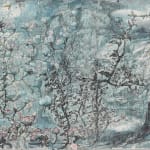-
作品
Peng Kanglong 彭康隆
Contained Virtues 含章可貞, 2020Ink and color on paper 紙本水墨設色19 1/8 x 318 7/8 in
48.5 x 810 cmCopyright The Artist含章可貞 坤卦六三 六三:含章可貞。或從王事,無成有終。 Kun: The third SIX, because of the virtue of pliability and preserve natural virtues, you can follow others virtues do great things. Although you can succeed, because...含章可貞 坤卦六三 六三:含章可貞。或從王事,無成有終。
Kun: The third SIX, because of the virtue of pliability and preserve natural virtues, you can follow others virtues do great things. Although you can succeed, because you only play a supporting role, success or failure will not belong to you. or failure will not belong to you.
Unlike Speak and Act Cautiously which explored the garden as a cultivated space between flower and landscape, Contained Virtues depicts only natural landscapes and wild flowers. The scroll opens with a scene deep in a remote forest. After passing through a thicket of trees, we come upon a high-mountain spring and river valley. Down a slope, we arrive at a vista that overlooks billowing mists, sheer mountain peaks and cascading waterfalls. After rounding the mid-ground mountain ridge, our view opens out across a deep mountain gorge to the peaks far off in the distance. The feeling is remote and austere and the image presented is not of man, or society, or art, or culture—but of nature.
Unlike Speak and Act Cautiously which explored polychrome harmonies and counterpoints, Contained Virtues sticks to blue-green monochrome throughout with only a single pink-crimson counterpoint. And unlike Speak and Act Cautiously which showcased Peng Kanglong’s virtuosic double outline brushwork, Contained Virtues employs boneless brushwork in both rendering flowers and landscape. In one key passage, chrysanthemum blooms rendered in double outline brushwork in pure ink transform into blooms rendered in boneless brushwork in heavy, thickly-layered cerulean-turquoise blue. These boneless chrysanthemums, in turn, transform into landscape bounders and hills. Further along, double outline peonies transform into boneless peonies—again, in thickly layered cerulean-turquoise. This time, however, the boneless peonies turn not into hills or mountains but into thickets of trees. In these transformations from double outline to boneless and from flower to landscape, Peng Kanglong is showing us that our distinctions—whether formal, technical or art historical—are arbitrary and only limit our freedom of imagination and action.
And finally, unlike Speak and Act Cautiously whose composition pivots around a solid, ink garden rock, Contained Virtues is centered around a quiet and nearly empty passage populated by a delicate tracery of wispy plants limned in dilute inks and hair-thin brushstrokes. On the right is a river valley barely visible, bathed in light. On the left is empty space cast in light gray shadow. So subtle and sparse is the ink, color and brushwork in this passage that we see for the first time the golden flecks—dried petals or leaves incorporated into Peng Kanglong’s bespoke paper—that dot the entire surface of the painting. Wildness and nature, transformation and non-distinction, stillness and awareness—are these the virtues that should be contained?
不同于《括囊无咎》将园林作为介于花卉与山水之间的空间进行探索,《含章可贞》只描绘了自然风景和野花。整幅长卷以一个山林深处的场景开始,穿过一片树丛,来到一处高山泉水与河谷地带。顺坡而下,视野逐渐开阔,得以俯瞰飘渺的薄雾、陡峭的山峰和飞流直下的瀑布。绕过画面中景的山脊,观者的视野豁然开朗,穿过深山峡谷,远处的山峰尽收眼底。这种感觉遥远而肃穆,呈现在我们眼前的不是人类或社会、艺术或文化,而是大自然的壮丽景观。




